This post may contain affiliate links. We may receive a small commission, at no cost to you, if you make a purchase. Read Disclosure.
If you’re thinking about doing a Montmartre food tour in Paris and are on the fence, I’m here to tell you to jump off on the right side of YES.
It will take you deeper than stunning Eiffel Tower views and art masterpieces to reveal a quieter, local side of Paris rich in history and, of course, French cuisine.
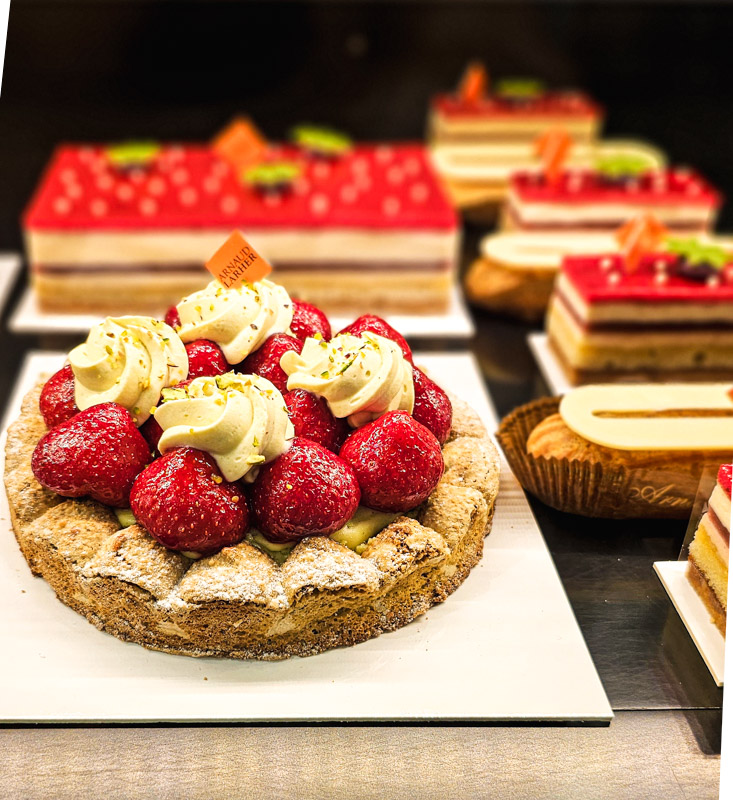
A walking food tour in Montmartre will give you a greater understanding of why French food and wine has the reputation that it does.
The French care about the quality of food, and the story their food tells – enough to protect it with labels, awards, strict preparation guidelines, and even UNESCO World Heritage protection.
We joined the Montmartre Like a Local Food Tour on a beautiful morning, and it quickly became one of my favorite neighborhoods in Paris.
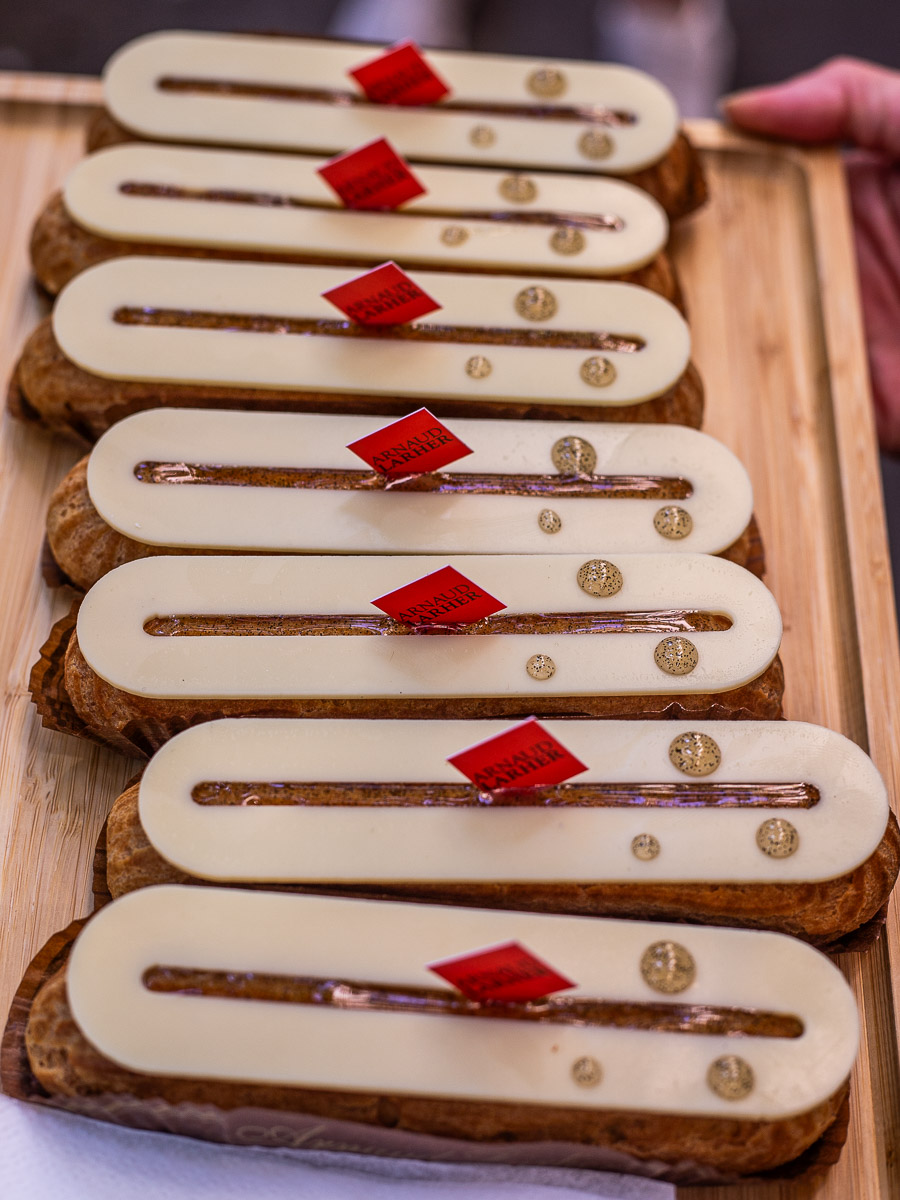
This area is well known for the popular tourist destination and the second most visited monument in Paris, Basilica Sacre Coeur, perched on a hill with beautiful views of the city, but we’re now claiming it as having one of the best food neighborhoods in Paris.
We joined Devour tours, a tour company that began the first Devour Tour in Madrid with founder Lauren Aloise’s vision to support the city’s struggling mom and pop shops.
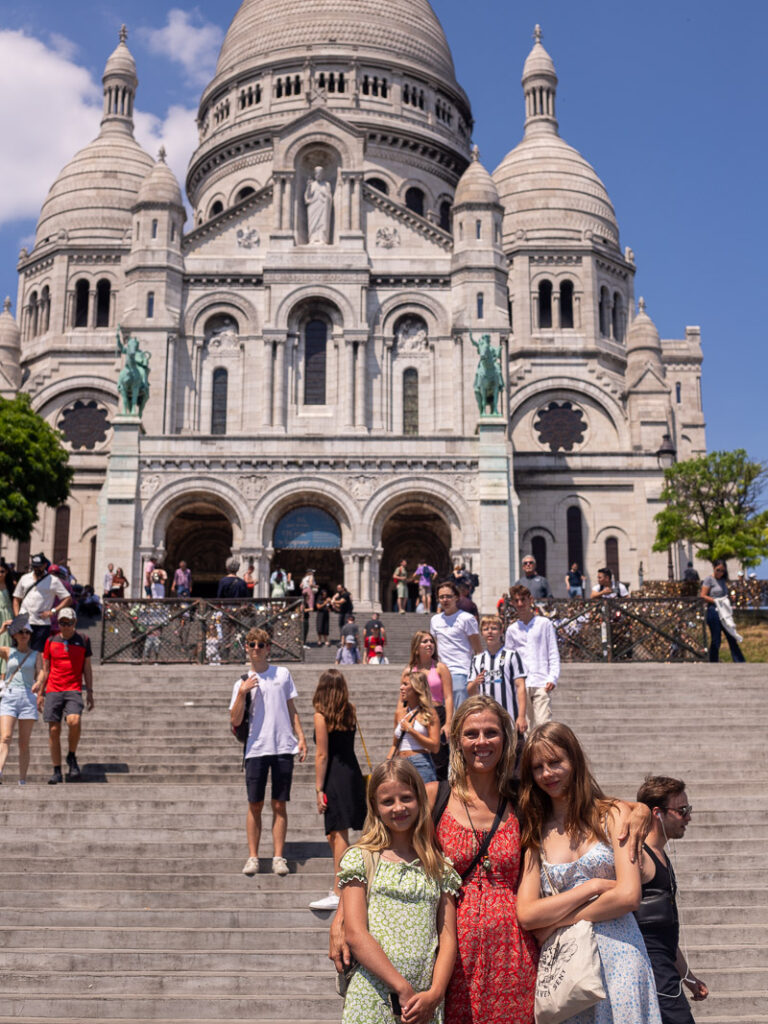
Their focus has always been on LOCAL- supporting small local shops and businesses, and sharing their stories, but also including local history, stories, and folklore as part of it.
They have recently joined with Walks of Italy, who we partnered with on our Europe trip for various walking tours. Read about the awesome food tour below, then don’t miss our 39 tips for going to Paris and our 4-day itinerary for Paris.
- A little About Montmartre, Paris
- Stops on the Montmartre Food Tour
- 1. Croissants at Boris Lumé Pâtisserie Boulangerie
- 2. Chocolate Eclairs from Arnaud Lahrer
- 3. Cheese and Baguettes at Epi
- 4. Pork mini burgers at Llétoile de Montmartre
- 5. Troubling Jewish Nazi History
- 6. Natural Wine Tasting at Les Naturistes
- 7. The Rabbit Cabaret and Vineyard
- 8. Basilica Sacre-Coeur
- 9. Quiche Provençal at L'été en Pente Douce
- FAQs About A Food Tour of Montmartre
- In Conclusion
A little About Montmartre, Paris
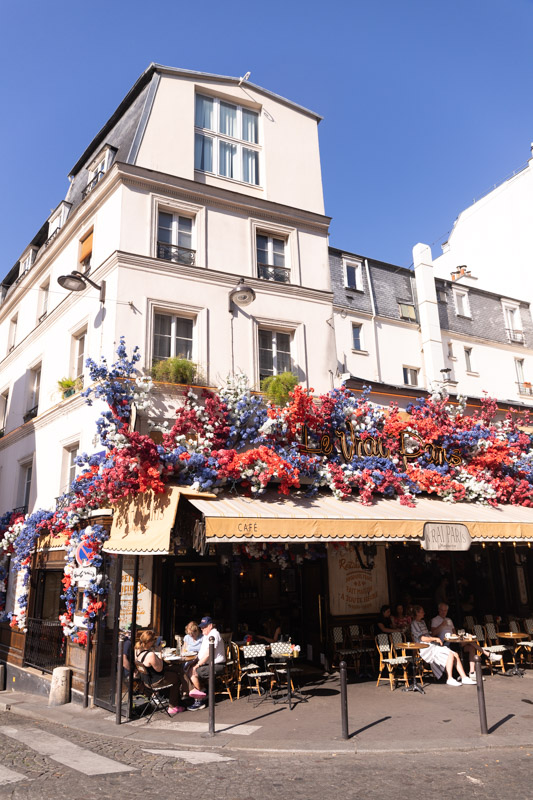
Our local guide, Julia, began the tour by introducing herself and our small group to each other and sharing a little about the origins of this village on a hill.
Although British, Julia has lived in Paris for over 20 years, and for some of that time in the Montmartre area. Her local knowledge steered us away from the touristy section of Montmartre to explore where the locals go.
Montmartre is the 18th arrondissement of Paris, the last neighborhood in the north of the city center. It wasn’t a part of the city until 1860 when Napoleon brought it into the city.
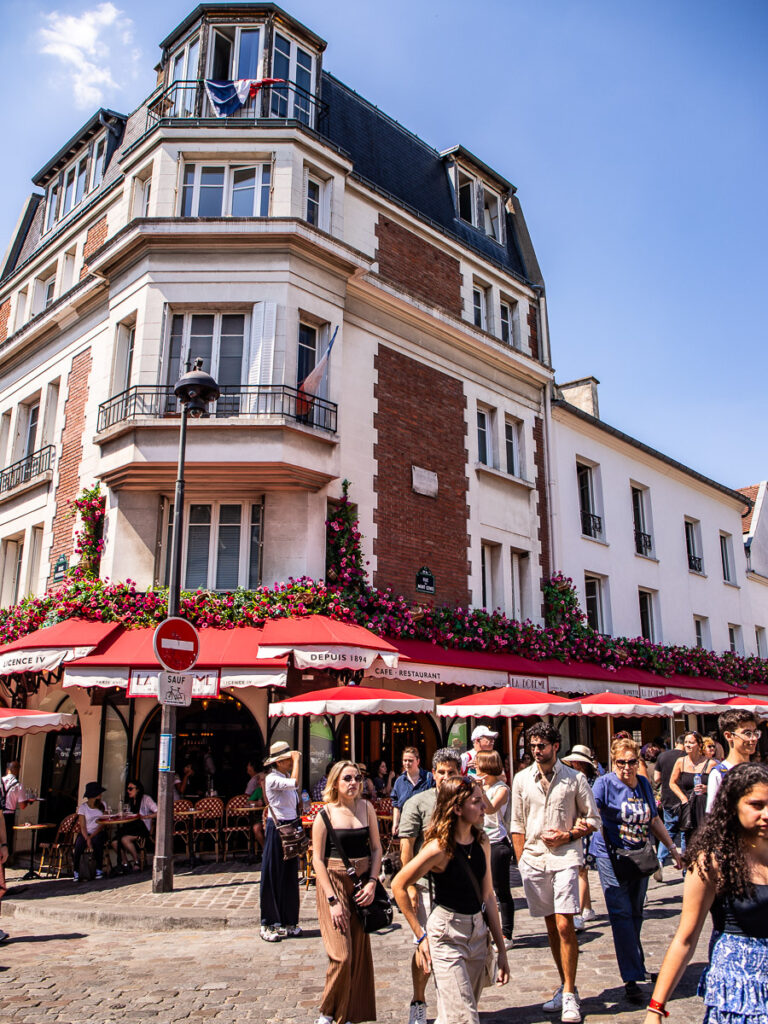
It was known for its artistic vibe. Everything was once cheaper here so it was where the artists would come to live and create. Even Renoir lived here in a shanty house.
Scrublands it is no more; Montmartre is an expensive and trendy place to live.
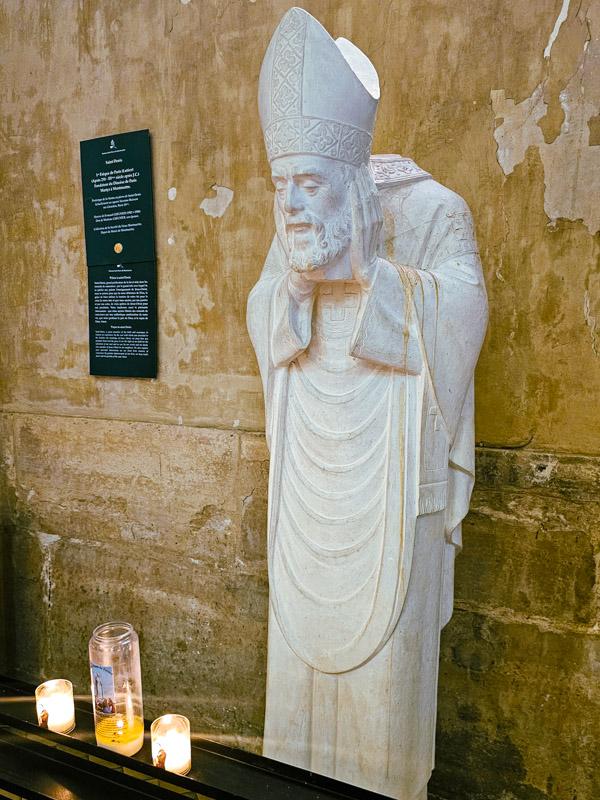
Montmartre’s name comes from 250AD when the Pope sent a priest to this area to convert the Pagans. Saint Denis wasn’t well received, and at some point, was sentenced to death, and had his head chopped off.
Legend says that Saint Dennis picked up his head and walked 6 miles to the, now area of Paris called Saint Denis, where he eventually died.
In French, Montmartre means the Mount of the Martyr. Saint Dennis became the patron Saint of Paris.
Julia also told us of Church of Saint-Pierre de Montmartre, the small church beside the Sacré Coeur, one of the oldest in Paris- where there is a statue of Saint Dennis holding his head.
Stops on the Montmartre Food Tour
After a little history, we walked to our first food experience of the tour, yes of course you guessed it – croissants. Would you want a Paris food tour to start in any other way?
1. Croissants at Boris Lumé Pâtisserie Boulangerie
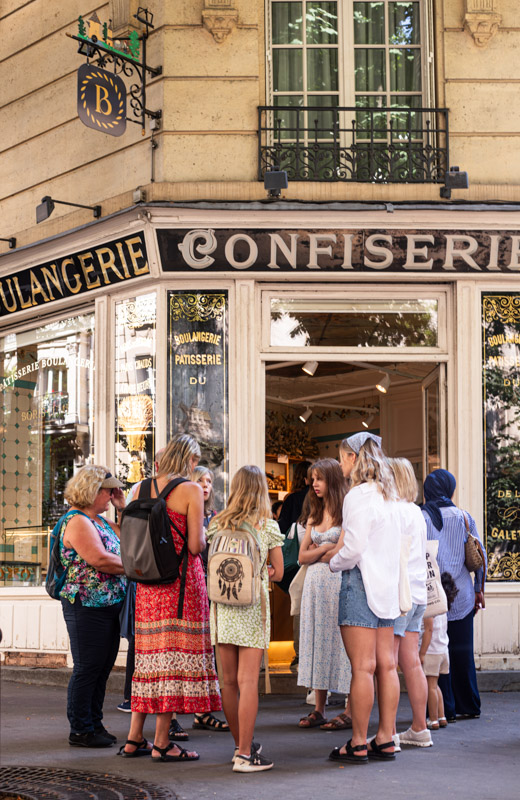
Boris Lume Patisserie Boulangerie is not only a place filled with exceptional pastries but is famous with a much younger crowd from around the world for other reasons.
This boulangerie is featured in the famous Miraculous Ladybug Show from Japan. If the girls weren’t already excited about eating French pastries, they were more so now for this unexpected connection to Cat Noir.
As we stood outside and bit into the buttery layers of the croissant – often made with up to 80 layers of pastry – we learned more of the history of this French any-time-of-the-day treat.
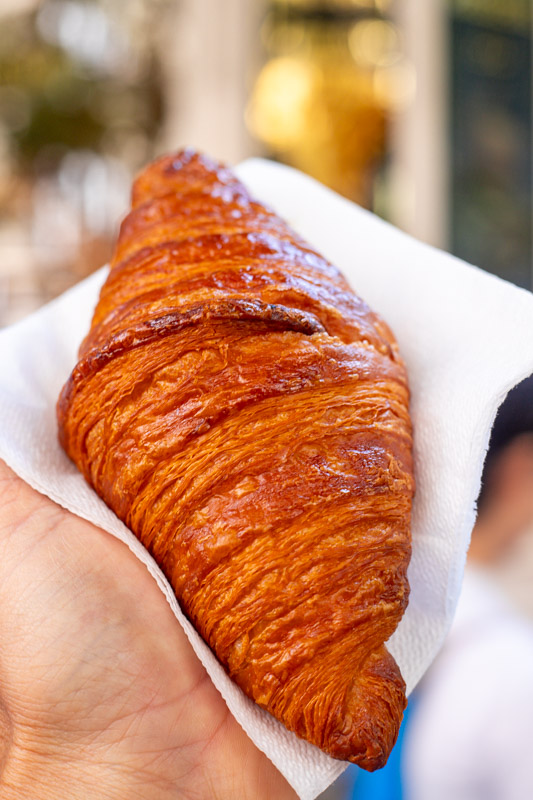
The croissant originated from Vienna and, legend has it, was created because of some victorious war defeating the Ottoman empire. To celebrate the pastries were shaped like the crescent on the Turkish Flag (which is what the French word croissant means).
Marie Antoinette bought these kipferls, her favorite pasty to France with her Viennese chef and it became a hit. But of course, they added in more butter and made it a little lighter and less sweet.
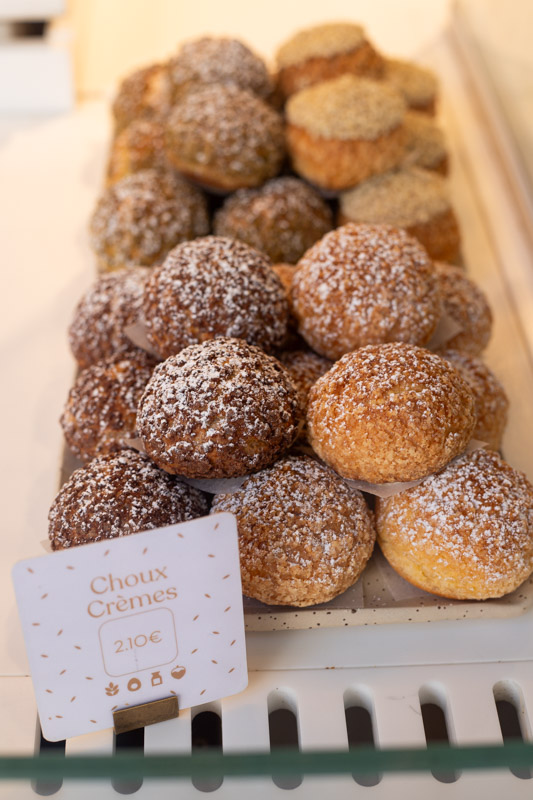
If you want to ensure a good pastry experience in France, then go to a boulangerie. That name comes with the obligation to follow strict rules and guidelines, which include that all pastries must be made fresh daily and by traditional methods only. If they’re caught, fines are big.
A traditional baguette can only be made using 4 ingredients and all baguettes must be the same size and weight. It’s so important to the world that UNESCO gave the French baguette global protection.
Now we had our breakfast, it was time for something sweet
2. Chocolate Eclairs from Arnaud Lahrer
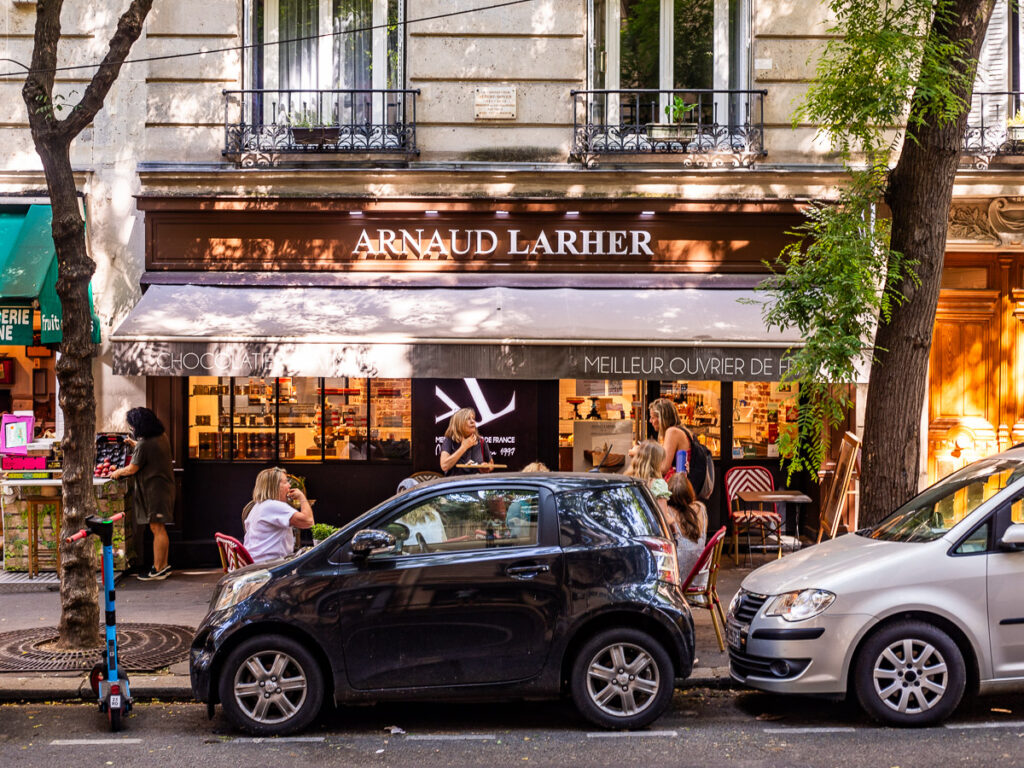
These ones were topped with a white chocolate hat, rather than chocolate icing over the pastry. Trust the master patisserie, Arnaud Larher on this one. I told you the French take food seriously.
Arnaud Lahrer was put through a year of grueling tests given by the French Ministry of Education to receive a highly prestigious award – Meilleur Ouvrier de France – given only to the best craftspeople in France every four years. The eclair was heaven.
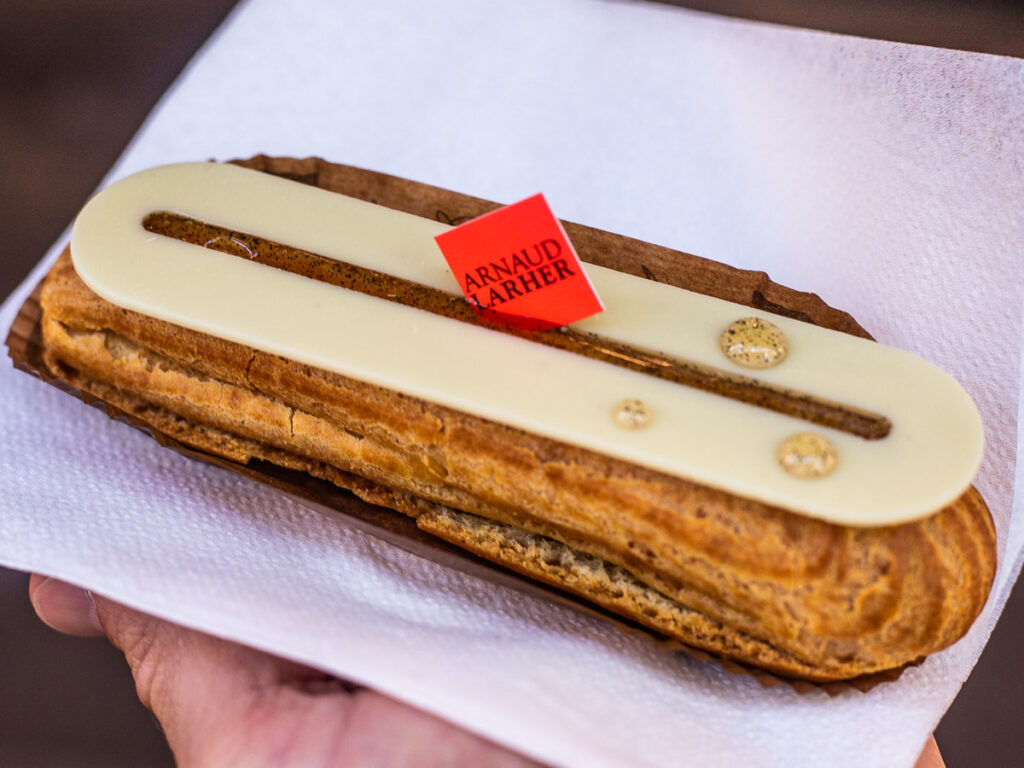
Although since I don’t have a sweet tooth, I much prefer the traditional milk chocolate coating with cream to this white chocolate one.
We also learned the origin of the word éclair – an invention using choux pastry (research) that was named so as the locals went crazy for them, “they’re eating these cakes as fast as lighting.” Yep. Éclair means lighting.
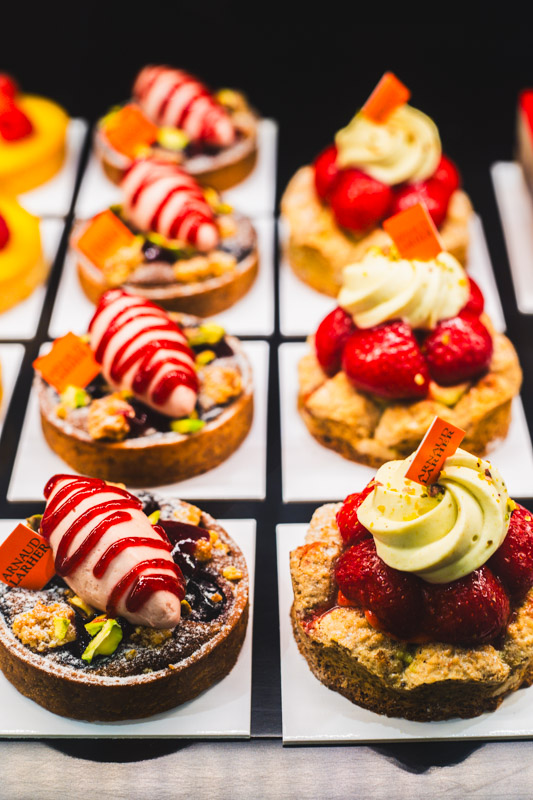
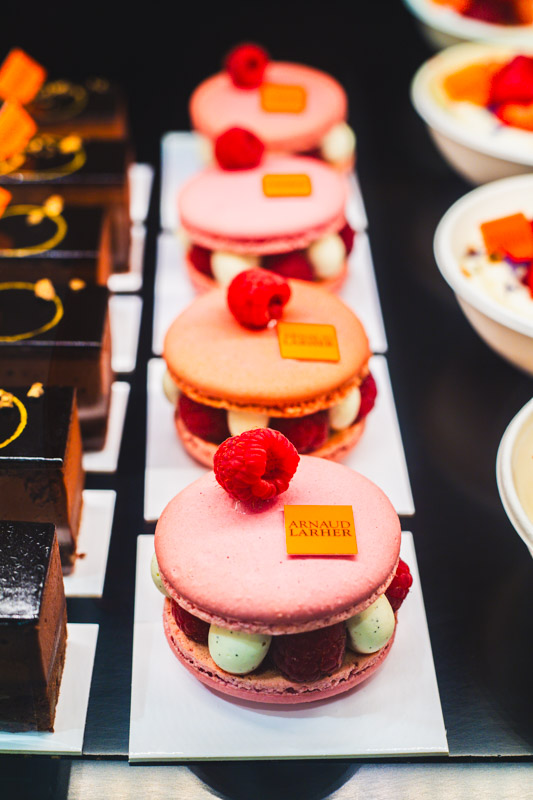
I was savoring every bite of my French pastries on this tour. I’m gluten intolerant and armed myself with gluten ease tablets so I could indulge when visiting the bakeries.
It’s rare I take the risk – and I was fully accepting of the consequences – but I couldn’t NOT eat pastries from one of the best in France. (I did not react anywhere near as bad as I would eating gluten in the US, so it was a good risk!)
3. Cheese and Baguettes at Epi
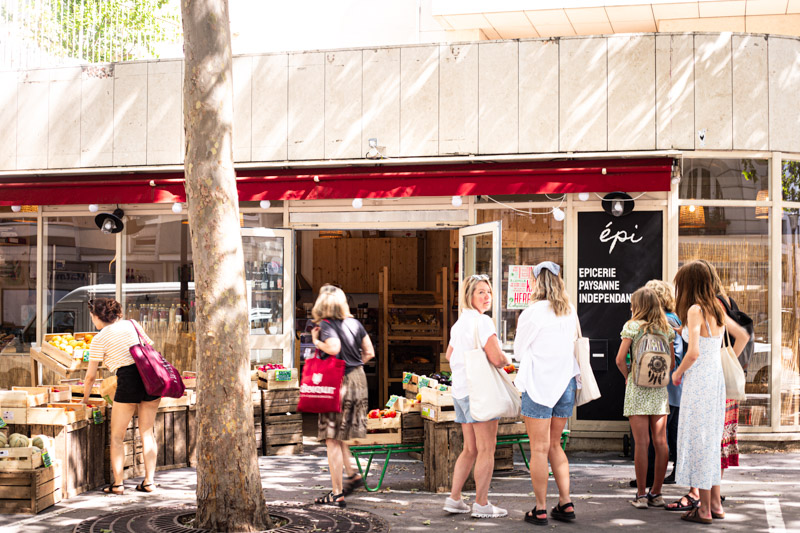
Okay, keeping the balance of flavors, our next stop was to a small independent grocery store called an Épicerie, which comes from a word meaning spices and now means small grocer.
This small, family-run cheese shop was filled with local organic produce, including French cheese, Prince of Paris ham, and gherkins.
We loaded all these on a table outside – along with a traditional baguette Julia bought with her – and made like we were French.
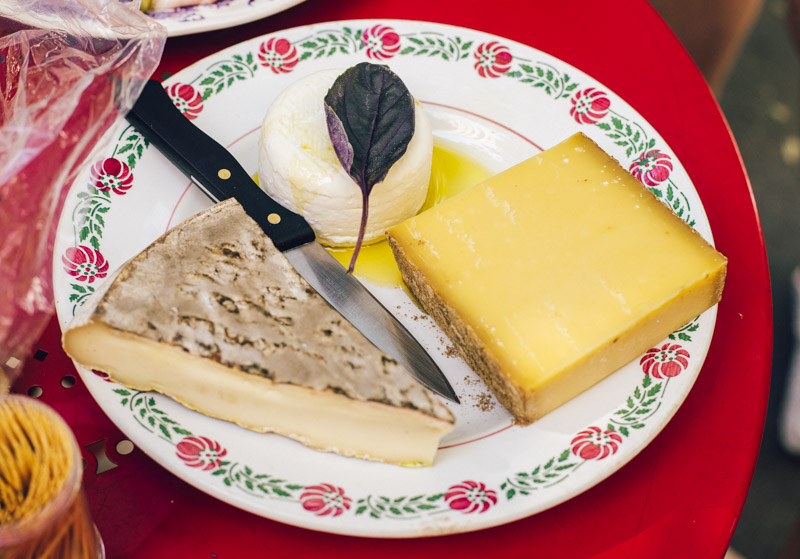
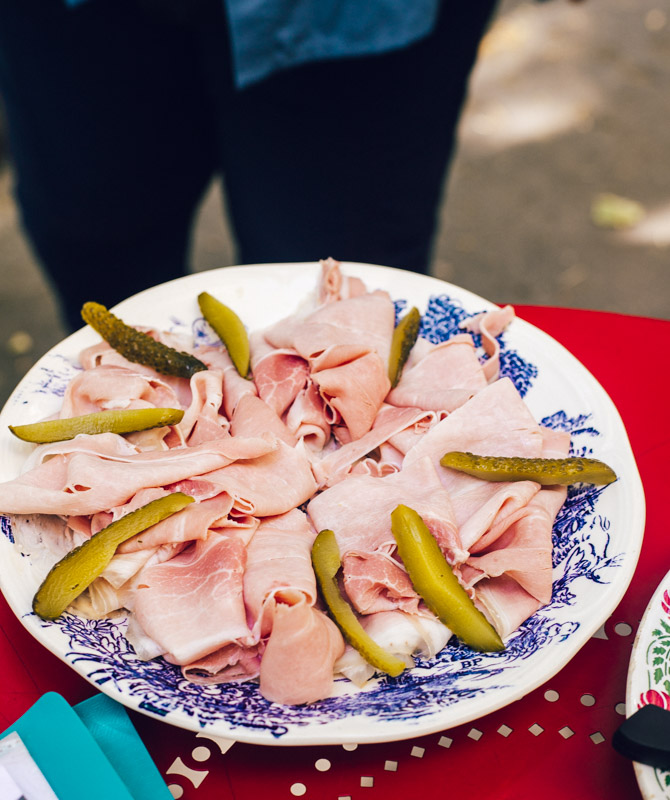
Our three styles of cheese were:
- Comte, a favorite of Parisians – a hard cheese made with raw milk and matured for 8 months.
- St Nectar Grey was a softer cheese with gray rinds that had been soaked in brine solution.
- And a goat’s cheese from near Normandy, which was very subtle in flavor and did not have the typical goat’s cheese tartness.
Except for the goat’s cheese, cheese in France is named after the region it comes from. Julia had a map to show us the regional cheeses and then flipped it over to show us the wine maps. The French way is to pair the cheese and wine from the same region.
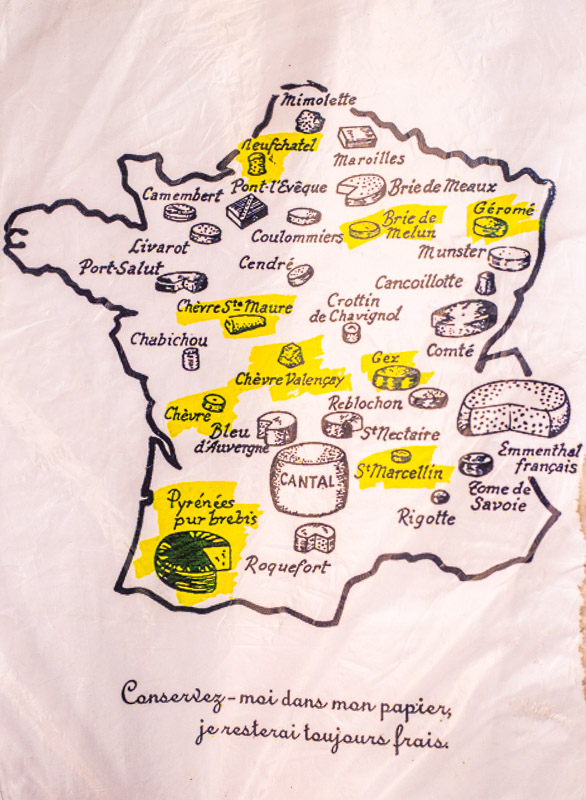
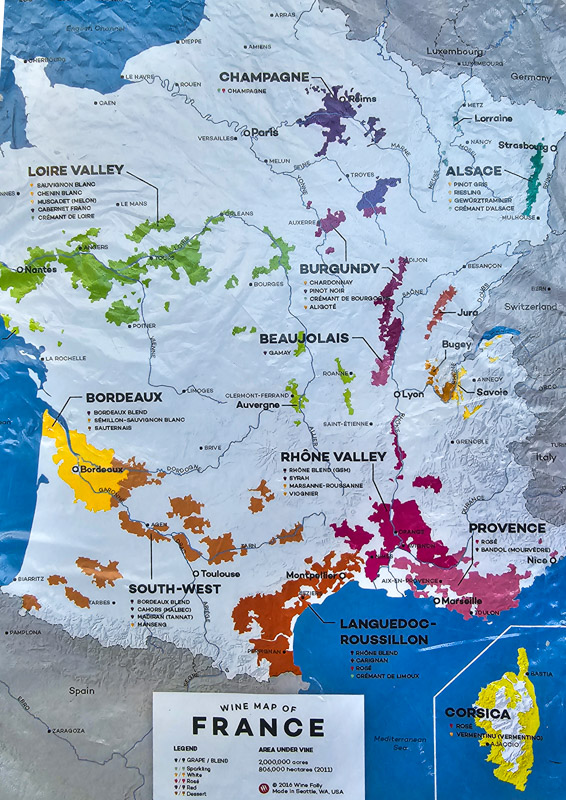
So now you know when it’s time for your charcuterie board and wine. And if you look for the AOC/AOP label (Appellation d’Origine Contrôlée or Protégée) which indicates the wine was created under strict conditions and has passed high quality control rules.
I think the French win for best cheese in the world. And of course, pastries. Any deniers out there?
Now we were ready for some more heartier food samplings.
4. Pork mini burgers at Llétoile de Montmartre
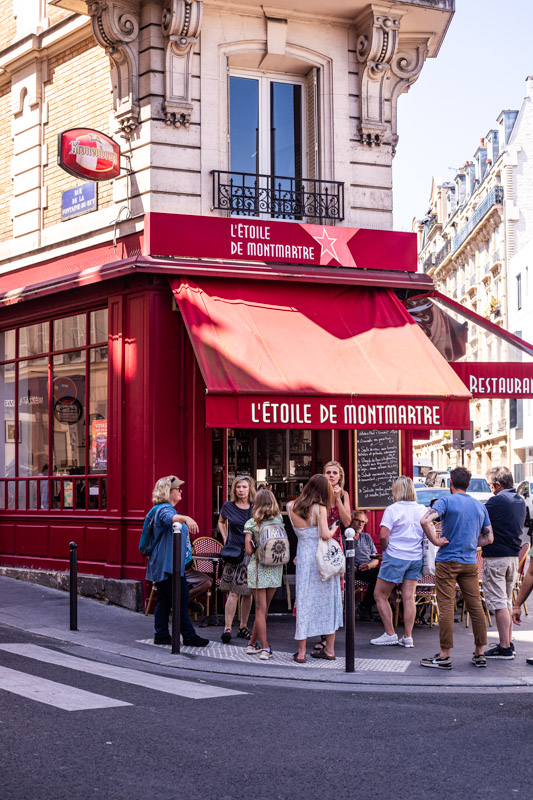
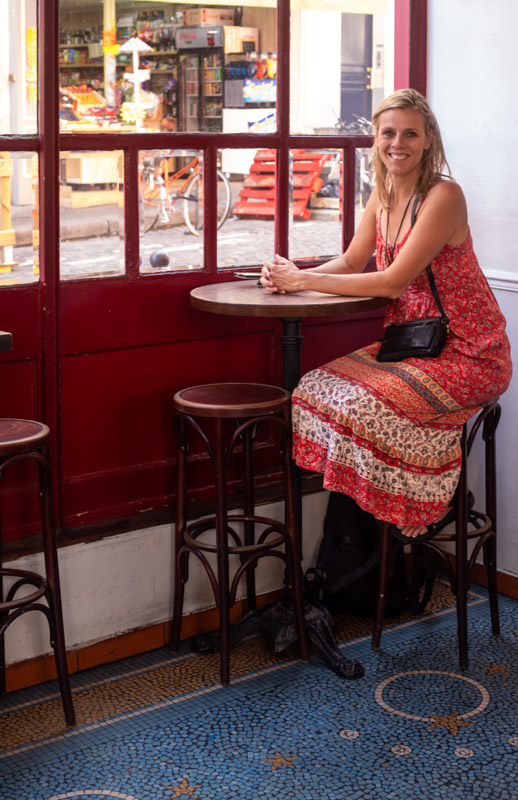
We headed to the small red Llétoile de Montmartre restaurant, which means star in French. It’s called this because it’s located on a Five points section of Montmartre (where five streets meet).
It’s a bistro from the 1920s recently taken over by three guys from the Occitane region of France. While we hadn’t walked a great deal, we enjoyed being able to sit down inside a restaurant for a bit and relax.
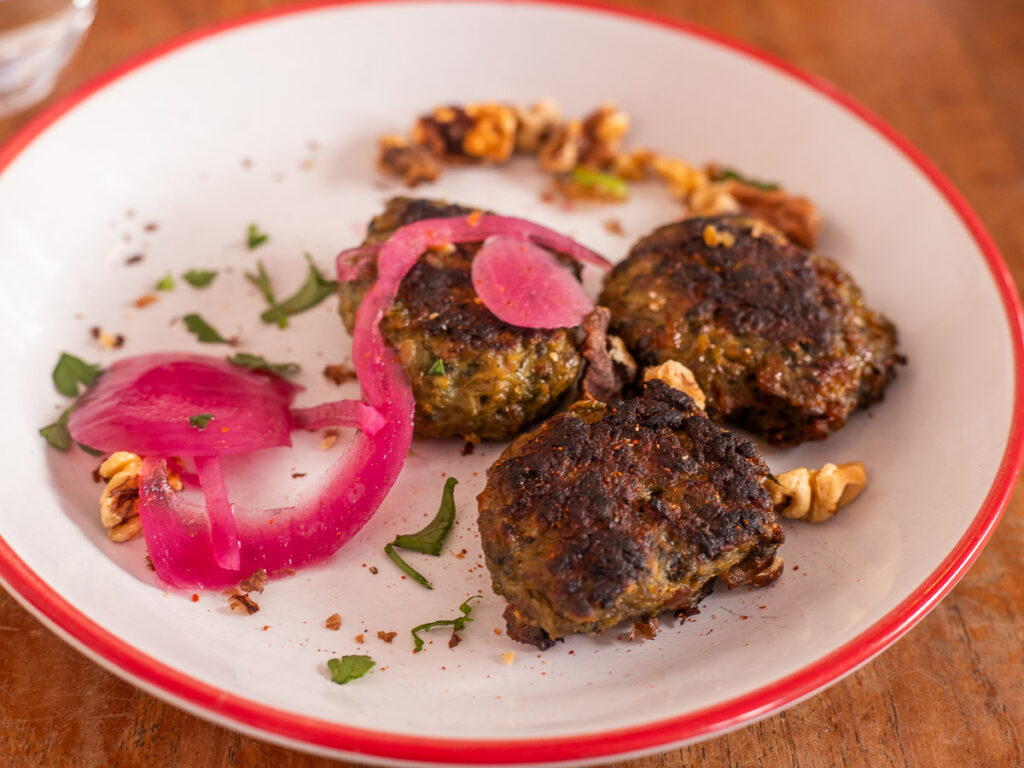
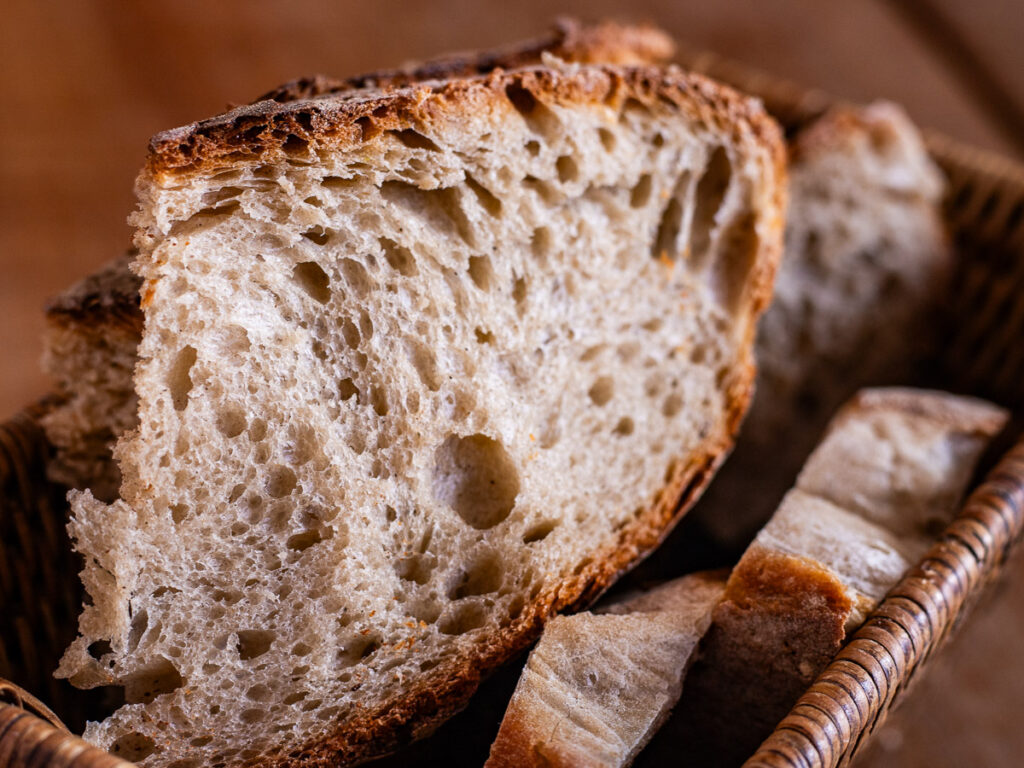
We had small samples of a pork mini burger mixed with onion, garlic and Swiss chard. They were delicious and I was grateful the girls did not finish theirs so I could eat just one more. Hey, they were small!
5. Troubling Jewish Nazi History
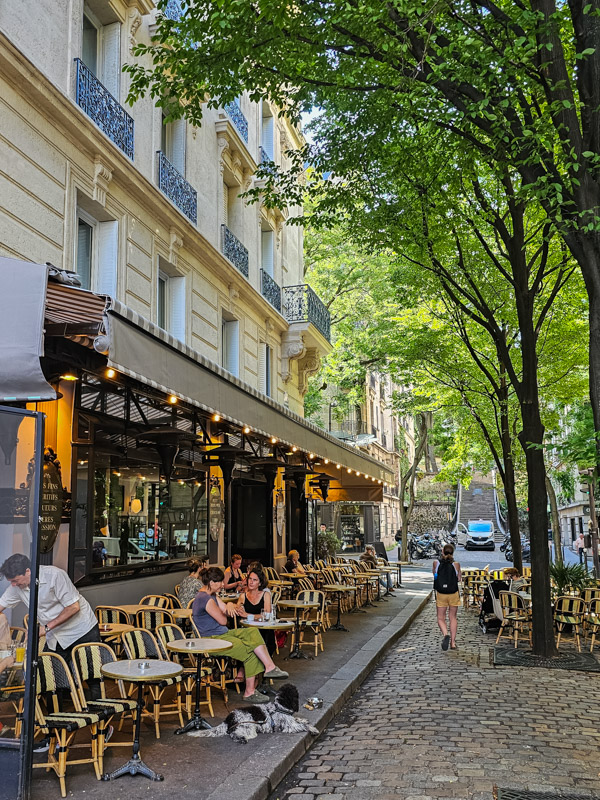
In walking to our next stop, we stopped at a plaque on the outside of a nondescript building honoring a Montmartre man who saved 85 children from the Nazi camp.
Julie shared with us a troubling – and often hidden fact – about the French governments’ complicity in sending Jews to the camps from 1842 – 44 when the Germans occupied the city.
The French government moved to Vichy in France after Paris was overtaken but they left it as an open city so the buildings wouldn’t get destroyed. The Jewish people living in Paris suffered as a result.
Marais is the Jewish quarter in Paris where you’ll see many plaques to remember these Jewish families. It is only recently that these plaques recognize that it was the Vichy government who sent and detained these Jews.
Many still say it’s not good enough as the plaques should say French government because that’s who it really was.
6. Natural Wine Tasting at Les Naturistes
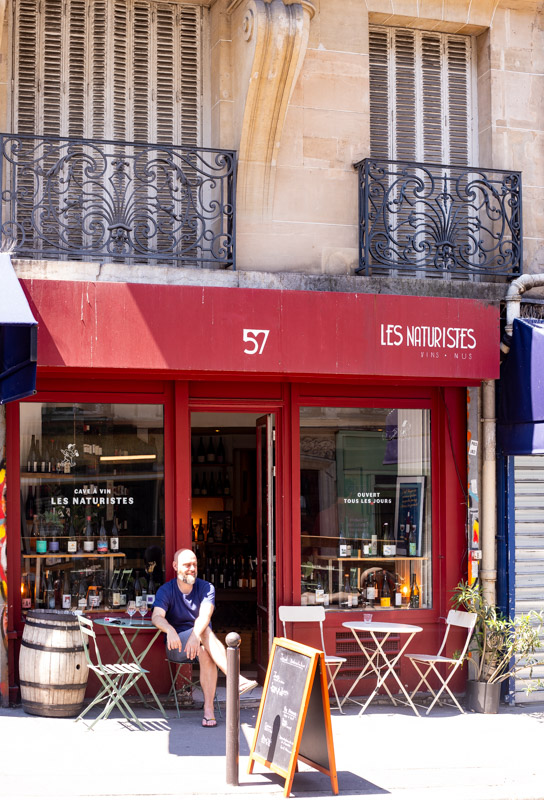
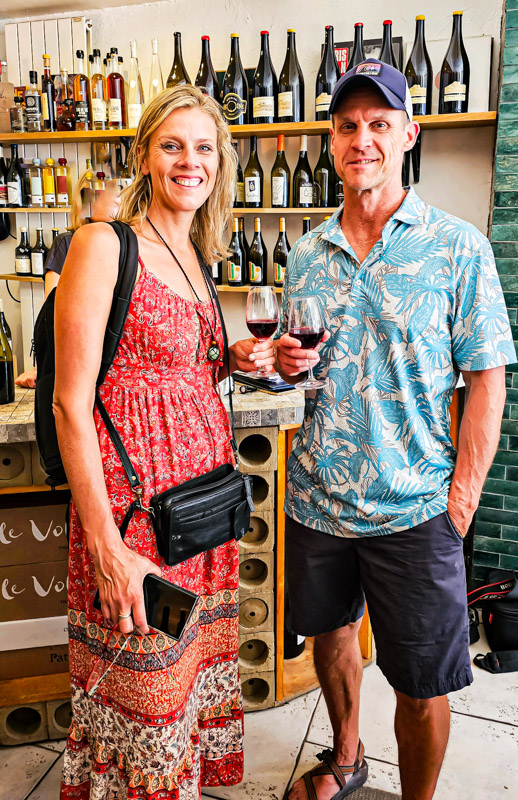
A fun stop on this food tour of Paris was a small naked wine shop. Naked because the wine is undressed, not because you are invited to!
All the wines in this small, independent wine store are French and free from crap!
You will find sulfites in these wines as sulfites are naturally occurring, but you won’t find any of the other chemical additives that many commercial wines enjoy adding in to help increase your hangover.
Another applause for the strict quality control of the French government. They are working to introduce new legislation to ensure bottle labels are clearer in describing what is in the wine.
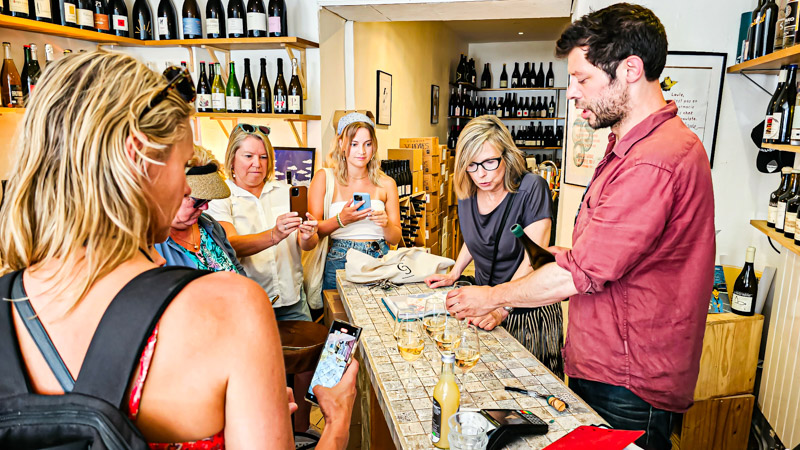
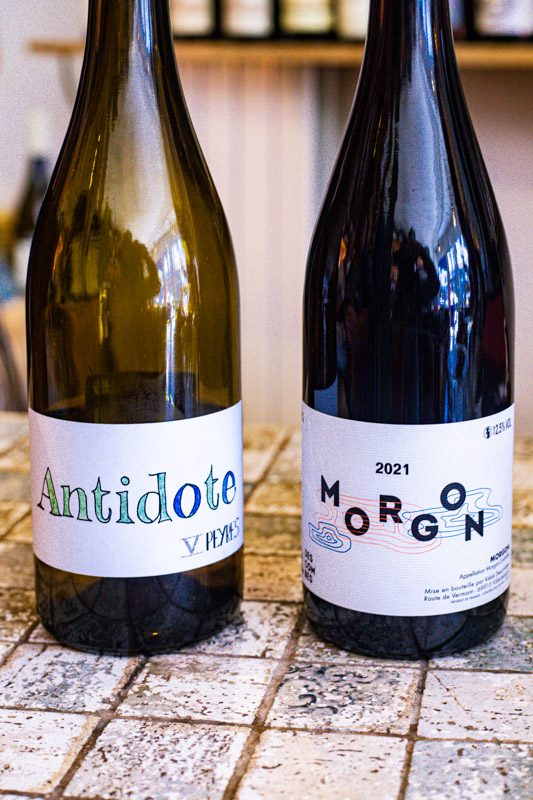
We sampled both red and white wines and found them both to be high quality, smooth to drink, and felt lower in alcohol content as I didn’t feel any buzz at all.
I much prefer drinking Old-World and natural wines now for these reasons and more. I was very appreciative that a natural wine shop was an addition to this Paris food tour.
On this stop, the girls were happy to sit out the front in the sun drinking sodas and using the free wi-fi.
7. The Rabbit Cabaret and Vineyard
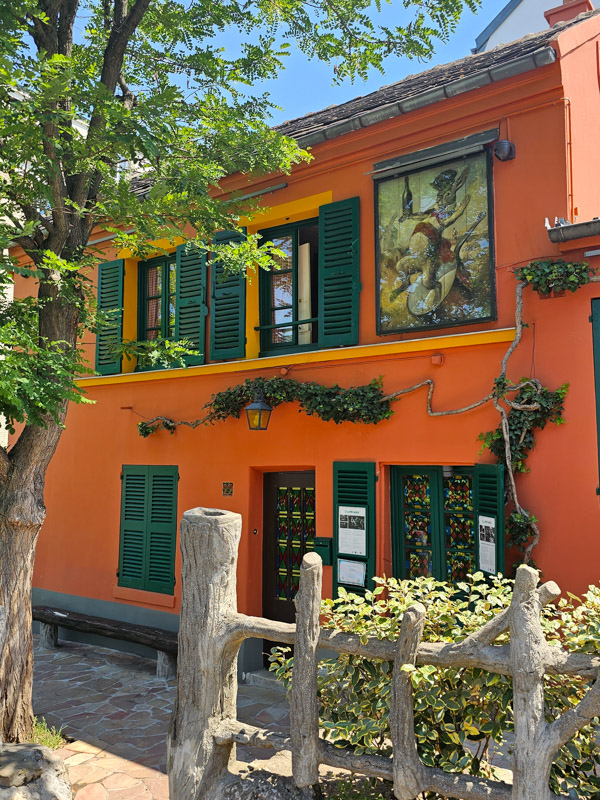
Before our last food tasting – yes, there are a lot isn’t there – we had a couple more history stops as we made our way to quiche.
I loved standing outside the bright orange Cabaret restaurant Au Lapin Agile, which originated in the 19th Century and had a specialty of rabbit stew.
This was a favored place for the struggling artists and writers of the area, many of whom would leave paintings to pay for the bill.
One of those was a French painter who left a painting of a rabbit jumping out of a pan, and so came the new name, Lapin Agile – the agile rabbit. The painting is now replicated on the building wall.
The other more interesting story is from a painter you might know, Picasso. He loved the cheap wine here, and one night when he could not pay his bill, he left a painting.
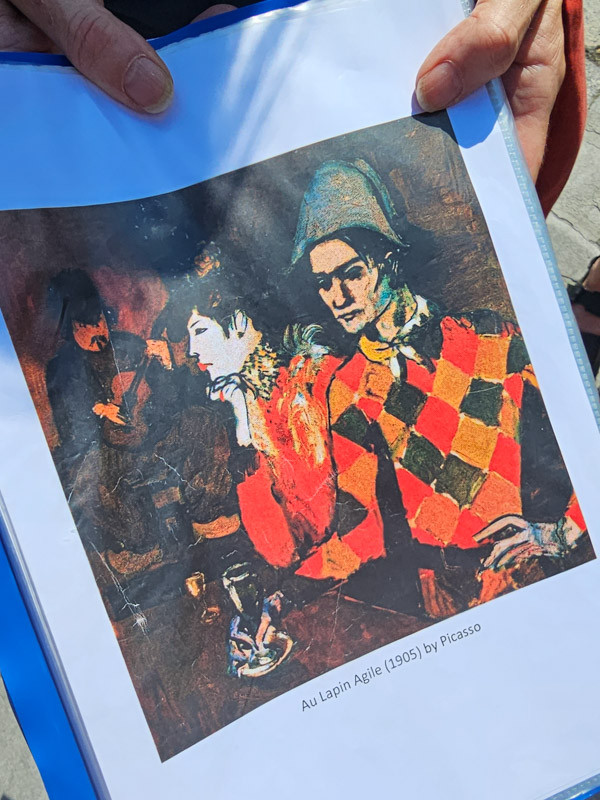
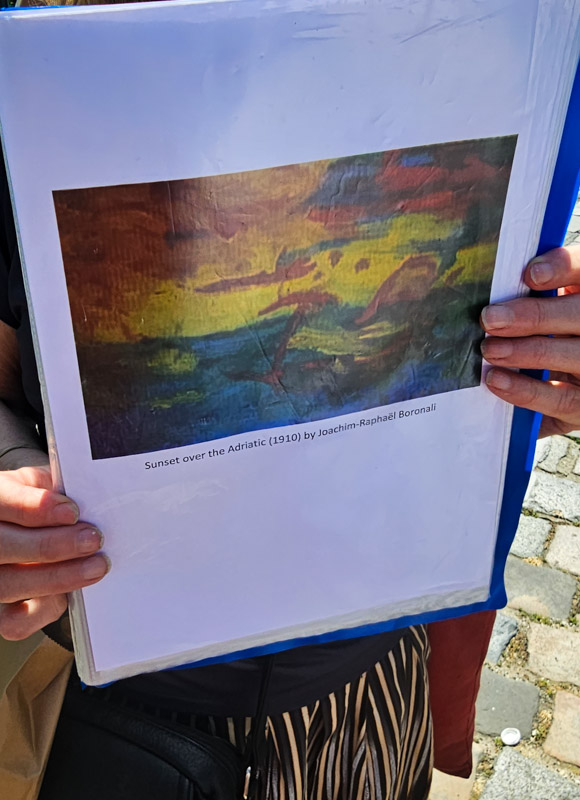
Picasso was not Picasso back then and the owner later sold the painting for 20 Franc to an American visitor. Years later that painting was sold for 40 million dollars to a private collector.
Another funny story is that of the painting of “Boronali ” which was highly favored by the art critics and was exhibited at an important art gallery.
Turns out this was a joke by a group of locals who had attached a brush dipped in different colors of paint to a donkey’s tail who then created the masterpiece!
Perhaps a chance to get back at the snobby art critics in Montmartre who are responsible for the term impressionist. condescendingly called this new art style impressionists – trying hard to make an impression.
Across from the cabaret restaurant was another fascinating look at local life in Montmartre. A small vineyard sits on an old plot of scrubland.
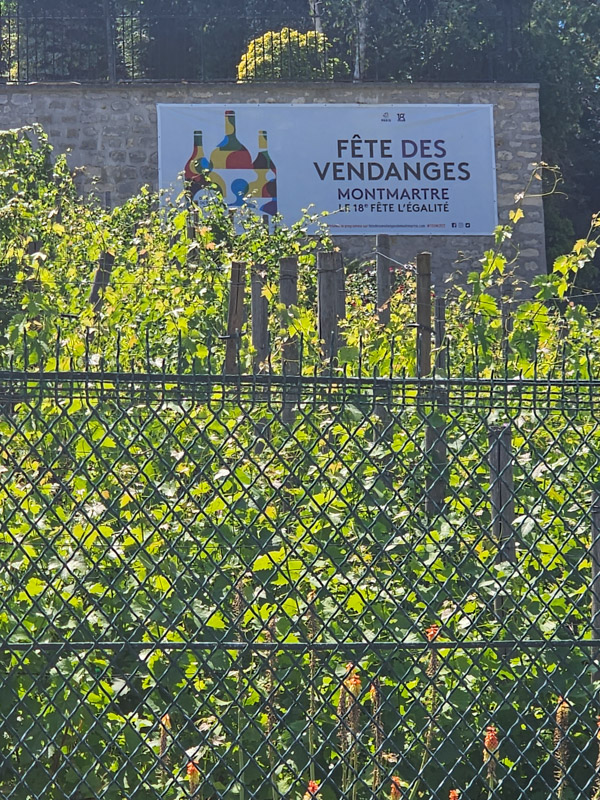
It started with the locals who were fed up with the development happening in the area and so came together to plant the vineyards. The French law states you can not build on a vineyard! I wish I could do that in Raleigh.
The vineyard started producing back in the 1930s and still does today, although Julia says it’s not very good. The tourist office now runs it, and all proceeds go to charity. Every year for harvest they have a big wine festival in the streets.
8. Basilica Sacre-Coeur
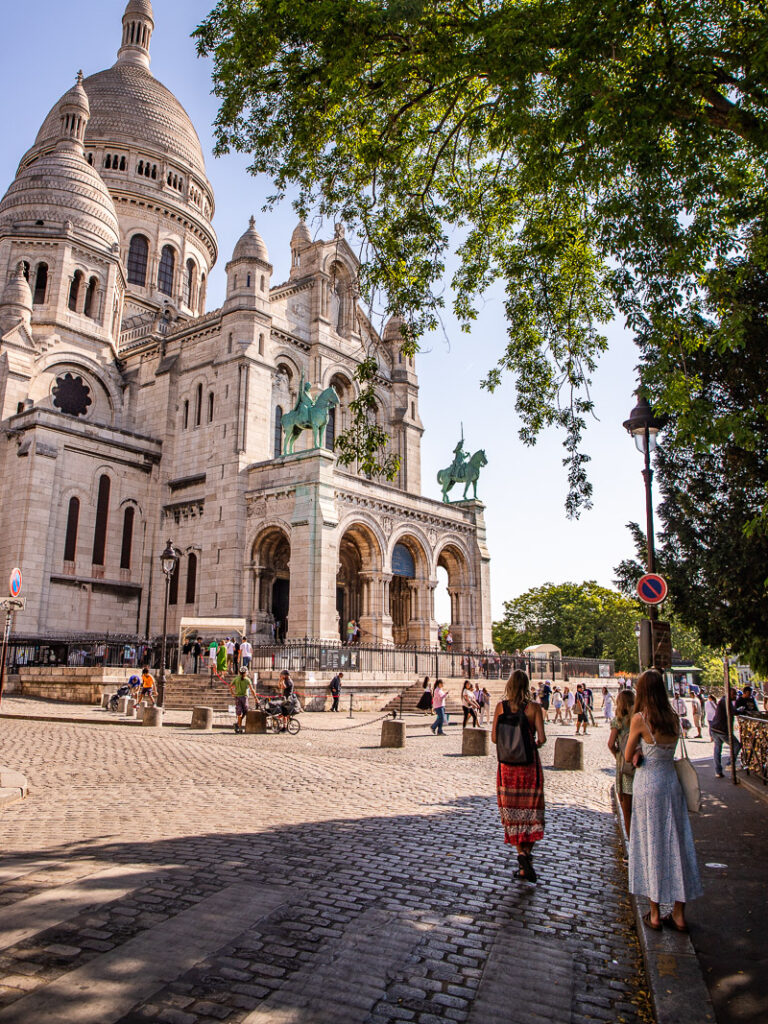
On this walking tour of Montmartre, you do stop at the Basilica Sacre-Coeur towards the end of the tour. You won’t waste precious eating time going inside it though, so leave time before or after the tour for that.
We stopped outside as Julia told us of its violent origins after the army brutally put down a protesting movement killing hundreds.
After this they decided to build a church in this debauchery area of free spirits because they needed it. Built by the very institution that brutally hunted them down and killed them.
Even still today there are many left wings who hate that Sacre Coeur was built on the blood of these people and many protests go on outside of it. Sacre-Coeur has been given protective status.
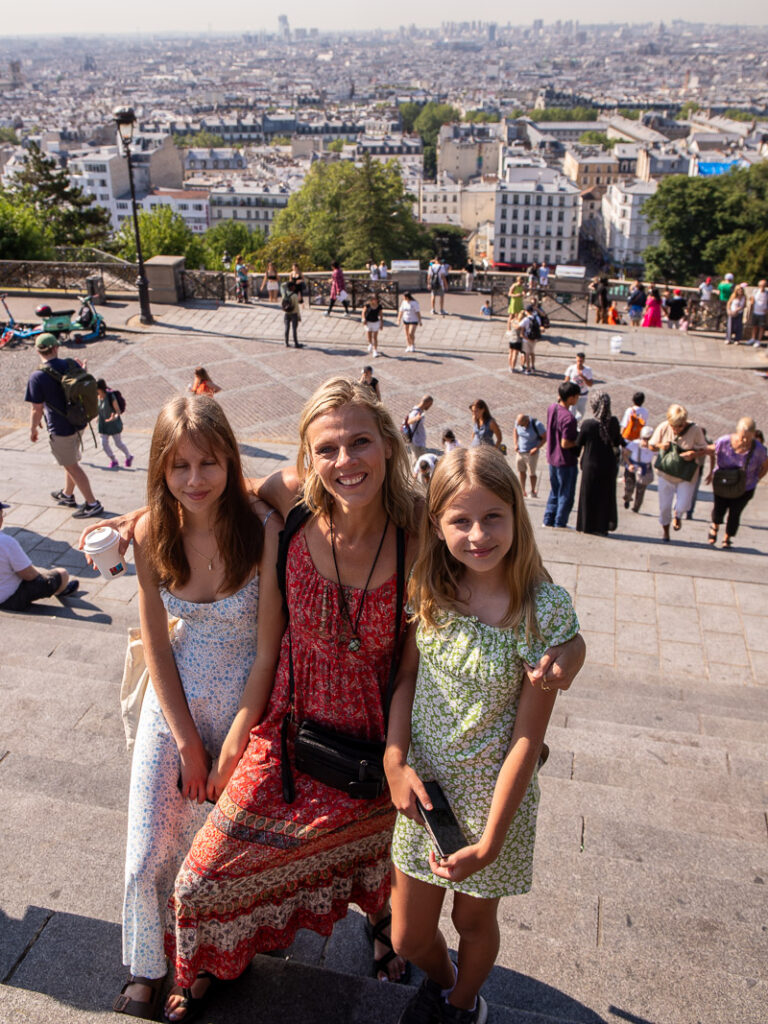
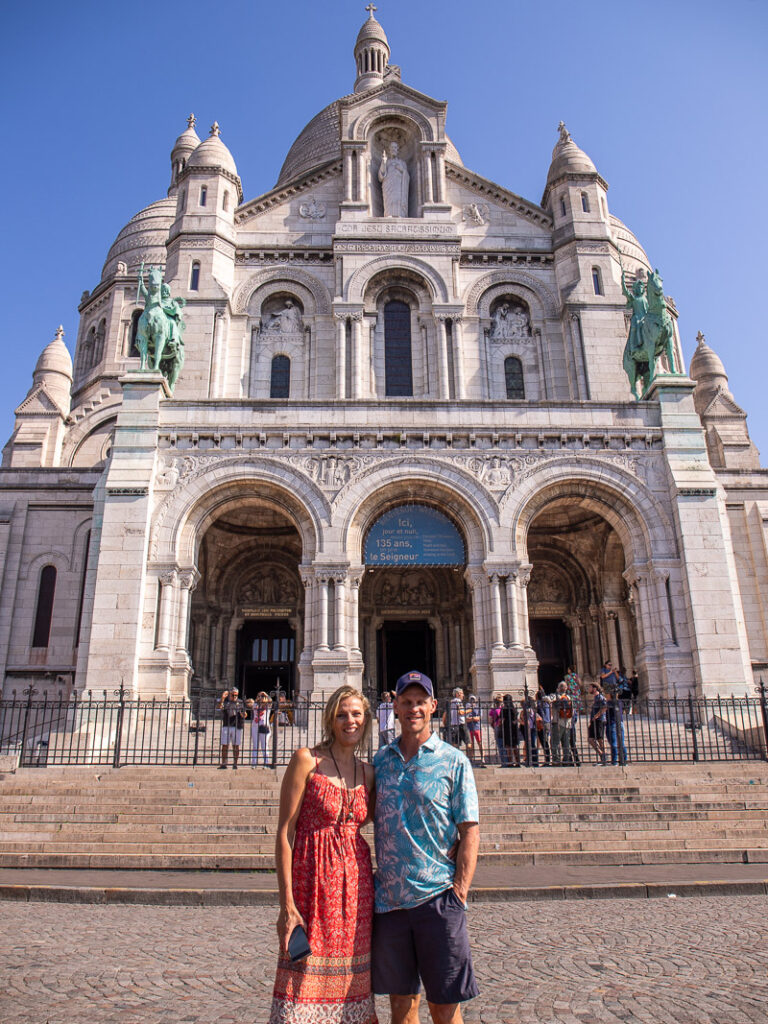
It is the newest church in Paris – with building starting in 1919. A competition was held for the designer, and it was made with stone that secretes a chemical that keeps it clean when it rains!
Julia pointed out the two blue-green statutes of the front façade of St Louis IX (the only King to ever be canonized (recognized as a Saint) by the Catholic Church) and Joan of Arc (canonized in 1920.). You can see St Louis IX holding a crown of thorns – he built Sainte Chapelle (an unmissable thing to do in Paris) to house them.
I’ll have more on the Sacre Coeur in our things to do in Montmartre post. Climbing the dome will give you one of the best views in Paris. For now, let’s eat one more time!
9. Quiche Provençal at L’été en Pente Douce
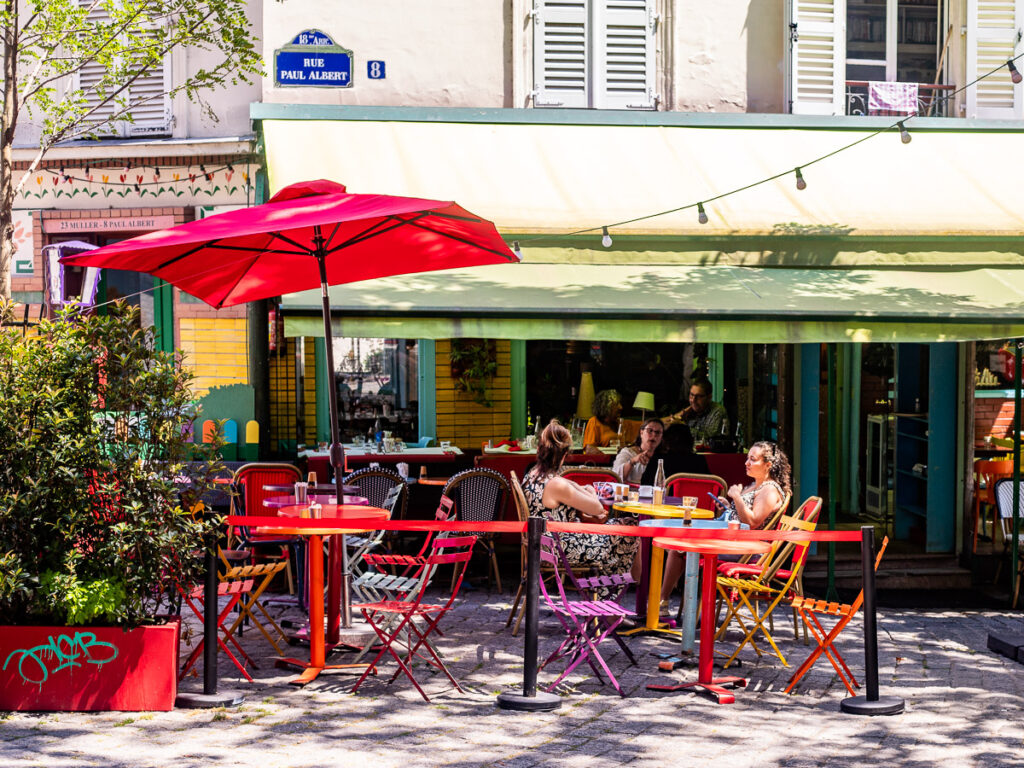
The last stop on the Montmartre walking food tour was for a delicious quiche. Down the bottom of the Sacre Coeur stairs L’été en pente douce which means summer on a gentle slope.
I was feeling that happy kind of vibes from the shady terrace filled with happy eaters.
This time we were eating another well-known French dish – quiche provincial – which originated in Germany. Well, it was East of France which throughout history was in and out of German control.
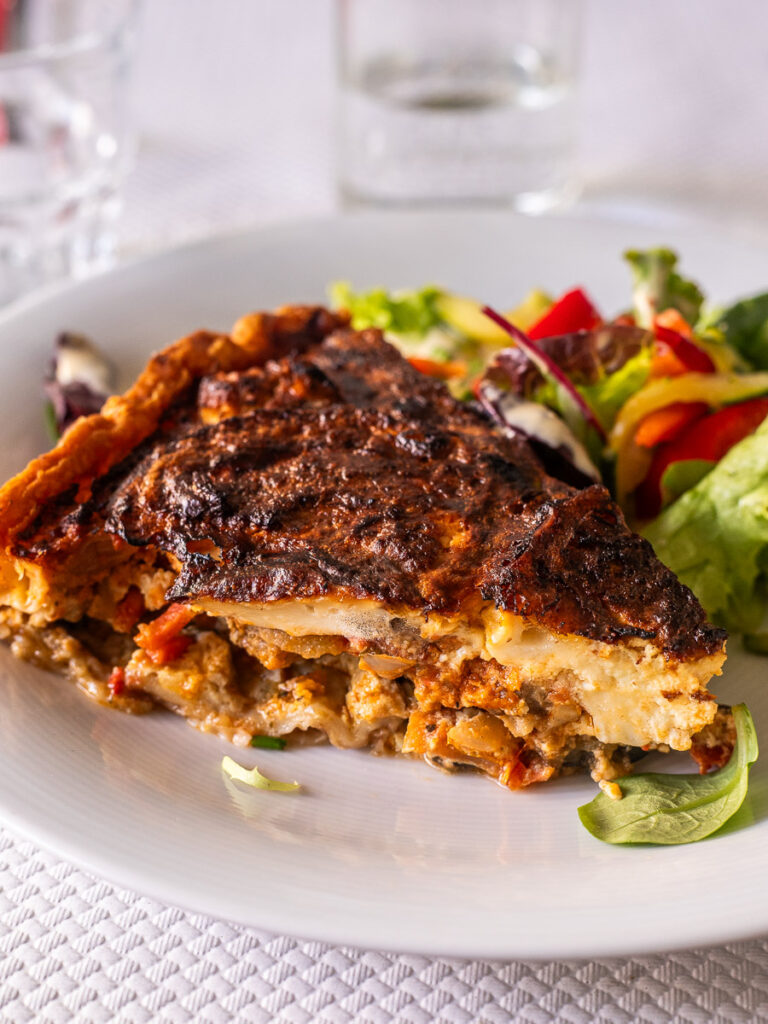
The locals in this region started making pies with bacon (Lorraine style) which then evolved into the base being more like a pastry than a bread dough.
It caught on and spread across the country in the middle of the 20th century with different fillings and styles. Our delicious quiche provincial was filled with goats’ cheese and eggplant. The pastry was so light, unlike most other quiches I have eaten.
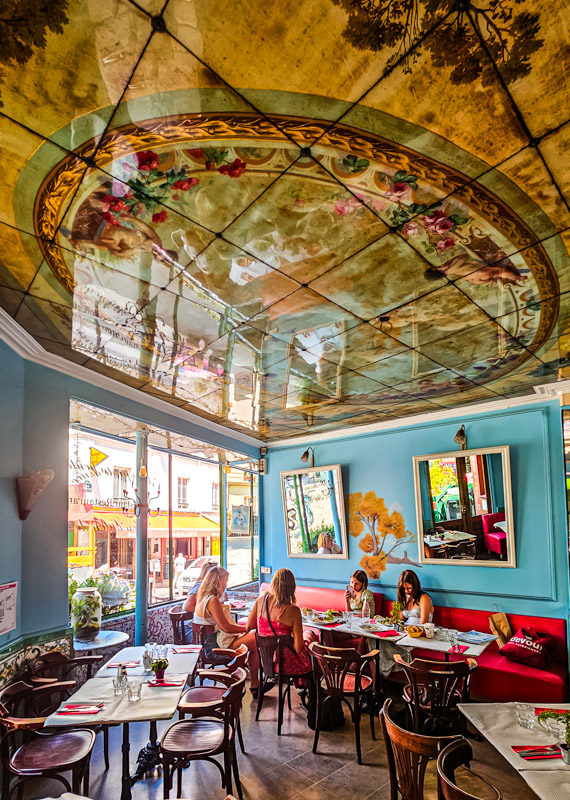
It was a wonderful end to a fantastic tour as we had time to sit and chat with the other people on our food tour.
I was so impressed with the quality and quantity of the food on this Paris walking tour. We definitely finished with zero space left in our bellies. Although I could have possibly squeezed in another eclair!
Check rates and availability for the Montmartre Food Tour here.
You may also be interested in these other Paris food tours by Devour:
- Paris at Sunset: Aperitif, Food & Wine Tour in the Latin Quarter
- Ultimate Paris Food Tour in Le Marias
- Paris Pastry and Chocolate Tour
- Complete French Wine Tasting in Paris in Montmartre
FAQs About A Food Tour of Montmartre
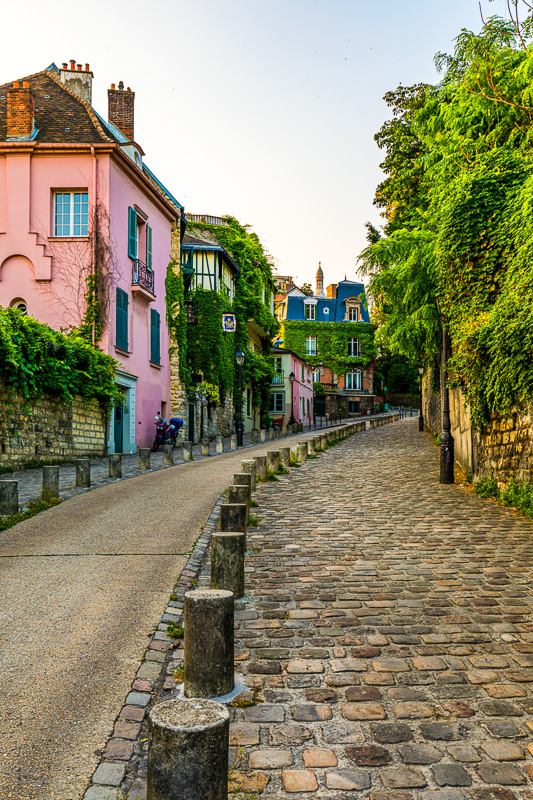
Here are some of the most commonly asked questions about doing a Montmartre food tour…
Where is the meeting point?
The meeting point is outside Anvers Metro station on line 2 on Monday – Friday, and on Saturday and Sunday and every evening tour at 6pm, it leaves from outside Abbesses metro station on line 12.
Look out for the orange umbrella!
What should I bring on a food tour?
I recommend you bring some drinking water and a hungry belly, as you will get to sample a lot of food!
You should also wear comfortable shoes and bring some money incase you want to purchase some of the food selections at each location.
Is a food tour of Montmartre good for kids?
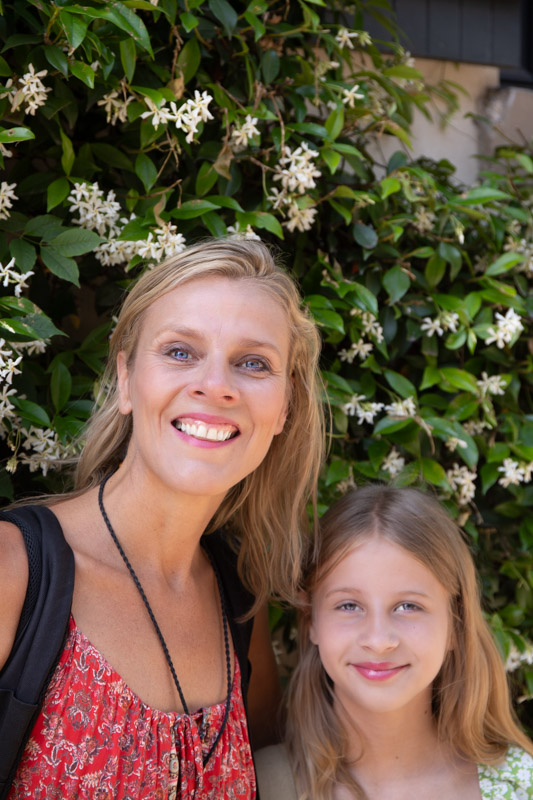
You may be wandering if a Montmartre food tour is good for kids? Absolutely yes. Even though one of the stops incorporated wine, our girls were happy to sit outside in the sun drinking a French soda instead.
The rest of the tour was invaluable to them (and we did a street food and history tour in Roma and Florence too!), although Kalyra felt it was a little too long. But, that is her teen attention span talking!
Kids love food just as much as adults and a tour like this opens a doorway for them to experience food as more than just something that ignites a taste bud party. It’s how you understand a culture.
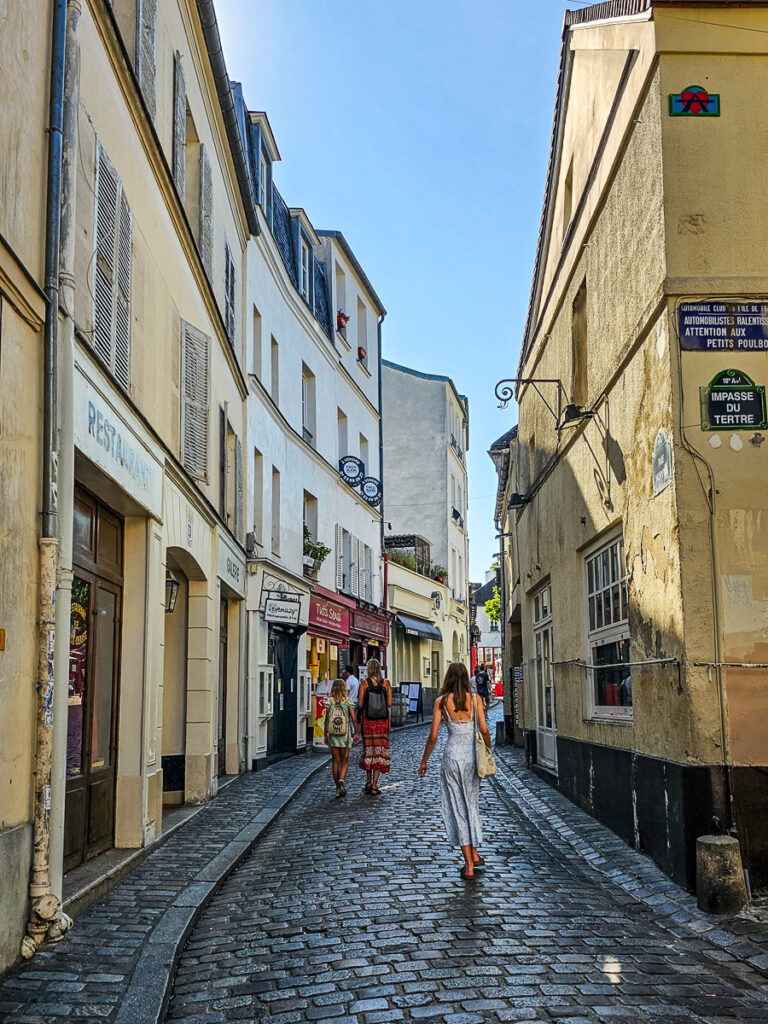
If you have a fussy eater, it might just be the thing they need to make a change. Savannah has always been the fussiest, plainest eater in the world, but she loves food tours as they help push her to be adventurous.
She tried everything on the tour, and while she didn’t finish the quiche or pork burgers, she at least had a go. Not too long ago, she never would have tried cheese and ham!
Now her number one requested travel experiences are always the best food tours or cooking classes. And besides, a French food tour with all those delicious pastries will excite any child!
In Conclusion
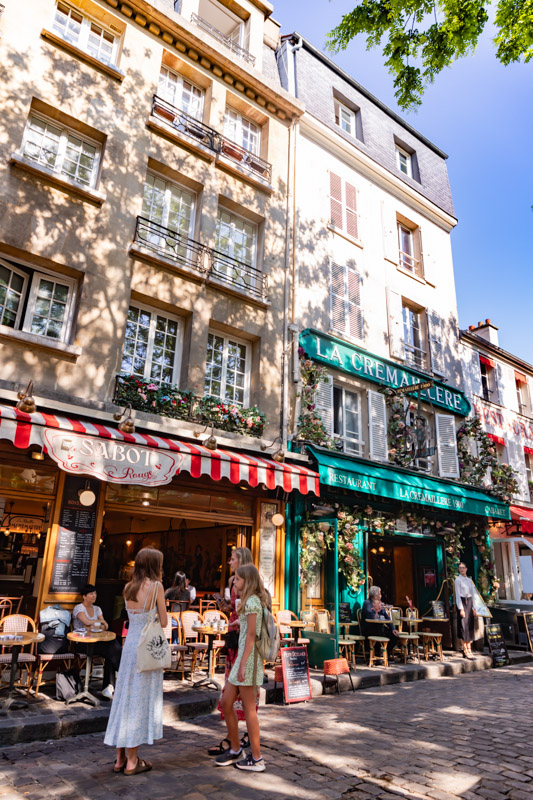
You could visit these places in Montmartre on your own. But one thing I’ve learned through my travels, especially on our European trip WITH our girls, is, if your budget allows, doing it on a small group food walking tour like this one with Devour is far better.
The more I do small group tours, the more I want to do them.
It’s a more personal experience filled with local knowledge, stories, and tips. You can just show up, get led around, ask questions, mingle with other travelers, and relax into the experience.
This Montmartre food walking tour was a smorgasbord of French flavors paired with a rich and fascinating history.
French history may have been a brutal one when it came to wars, conquests, and religious persecution, but the other side of that history are great lessons on paying reverence to food and respect to the terroir that produces it. It is an admirable part of French culture that I enjoy savoring.
We had an incredible time in Paris for four days, experiencing some of its top tourist attractions, and we all agreed that the Paris food walking tour of Montmartre was the best thing we did! Here are some more things to do in Paris with teens.
You can also read our tips on how to plan a trip to Europe with kids and tips for visiting Europe with kids.